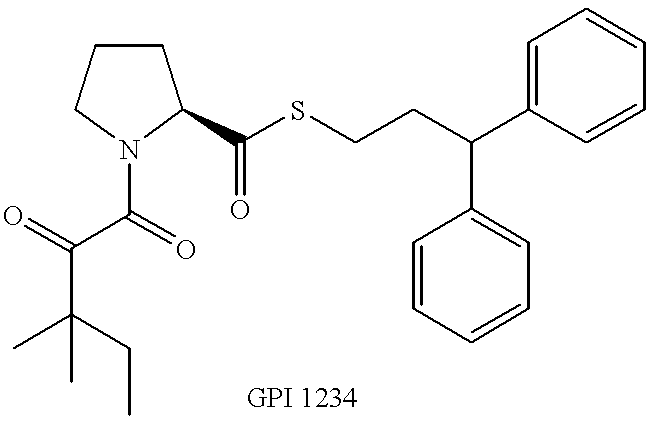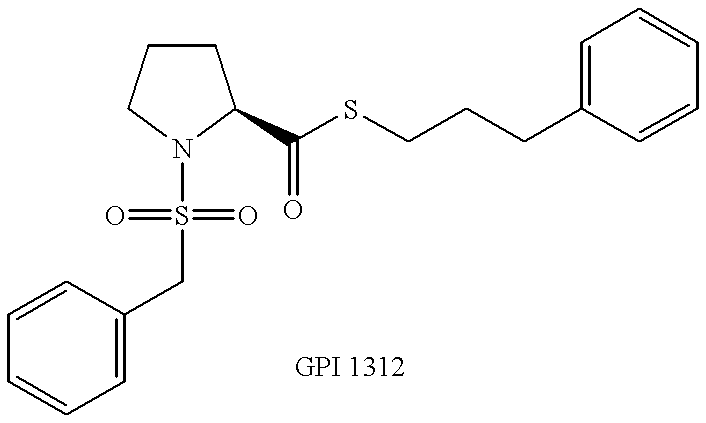Pyrrolidine derivatives for vision and memory disorders
- Summary
- Abstract
- Description
- Claims
- Application Information
AI Technical Summary
Problems solved by technology
Method used
Image
Examples
example 1
Synthesis of 3-phenyl-1-propyl (2S)-1-(3,3-dimethyl-1,2-dioxopentyl)-2-pyrrolidinecarboxylate (1)
Methyl (2S)-1-(1,2-dioxo-2-methoxyethyl)-2-pyrrolidinecarboxylate
A solution of L-proline methyl ester hydrochloride (3.08 g; 18.60 mmol) in dry methylene chloride was cooled to 0.degree. C. and treated with triethylamine (3.92 g; 38.74 mmol; 2.1 eq). After stirring the formed slurry under a nitrogen atmosphere for 15 min, a solution of methyl oxalyl chloride (3.20 g; 26.12 mmol) in methylene chloride (45 ml) was added dropwise. The resulting mixture was stirred at 0.degree. C. for 1.5 hour. After filtering to remove solids, the organic phase was washed with water, dried over MgSO.sub.4 and concentrated. The crude residue was purified on a silica gel column, eluting with 50% ethyl acetate in hexane, to obtain 3.52 g (88%) of the product as a reddish oil. Mixture of cis-trans amide rotamers; data for trans rotamer given. .sup.1 H NMR (CDCl.sub.3): d 1.93 (dm, 2H); 2.17 (m, 2H); 3.62 (m, 2H...
example 2
The method of Example 1 was utilized to prepare the following illustrative compounds:
Compound 2: 3-phenyl-1-prop-2-(E)-enyl (2S)-1-(3,3-dimethyl-1,2-dioxopentyl)-2-pyrrolidinecarboxylate, 80%. .sup.1 H NMR (360 MHZ, CDCl.sub.3): d 0.86 (t, 3H); 1.21 (s, 3H); 1.25 (s, 3H); 1.54-2.10 (m, 5H); 2.10-2.37 (m, 1H); 3.52-3.55 (m, 2H); 4.56 (dd, 1H, J=3.8, 8.9); 4.78-4.83 (m, 2H); 6.27 (m, 1H); 6.67 (dd, 1H, J=15.9); 7.13-7.50 (m, 5H).
Compound 3: 3-(3,4,5-trimethoxyphenyl)-1-propyl (2S)-1-(3,3-dimethyl-1,2-dioxopentyl)-2-pyrrolidine-carboxylate, 61%. .sup.1 H NMR (CDCl.sub.3): d 0.84 (t, 3H); 1.15 (s, 3H); 1.24 (s, 3H); 1.71 (dm, 2H); 1.98 (m, 5H); 2.24 (m, 1H); 2.63 (m, 2H); 3.51 (t, 2H); 3.79 (s, 3H); 3.83 (s, 3H); 4.14 (m, 2H); 4.52 (m, 1H); 6.36 (s, 2H).
Compound 4: 3-(3,4,5-trimethoxyphenyl)-1-prop-2-(E)-enyl (2S)-1-(3,3-dimethyl-1,2-dioxopentyl)-2-pyrrolidine carboxylate, 66%. .sup.1 H NMR (CDCl.sub.3): d 0.85 (t, 3H); 1.22 (s, 3H); 1.25 (s, 3H); 1.50-2.11 (m, 5H); 2.11-2.40 (m, 1H); 3...
example 3
General procedure for the synthesis of acrylic esters, exemplified for methyl (3,3,5-trimethoxy)-trans-cinnamate.
A solution of 3,4,5-trimethoxybenzaldehyde (5.0 g; 25.48 mmol) and methyl (triphenyl-phosphoranylidene)acetate (10.0 g; 29.91 mmol) in tetrahydrofuran (250 ml) was refluxed overnight. After cooling, the reaction mixture was diluted with 200 ml of ethyl acetate and washed with 2.times.200 ml of water, dried, and concentrated in vacuo. The crude residue was chromatographed on a silica gel column, eluting with 25% ethyl acetate in hexane, to obtain 5.63 g (88%) of the cinnamate as a white crystalline solid. .sup.1 H NMR (300 MHz; CDCl.sub.3): d 3.78 (s, 3H); 3.85 (s, 6H); 6.32 (d, 1H, J=16); 6.72 (s, 2H); 7.59 (d, 1H, J=16).
PUM
| Property | Measurement | Unit |
|---|---|---|
| Molar density | aaaaa | aaaaa |
| Fraction | aaaaa | aaaaa |
| Fraction | aaaaa | aaaaa |
Abstract
Description
Claims
Application Information
 Login to View More
Login to View More - R&D
- Intellectual Property
- Life Sciences
- Materials
- Tech Scout
- Unparalleled Data Quality
- Higher Quality Content
- 60% Fewer Hallucinations
Browse by: Latest US Patents, China's latest patents, Technical Efficacy Thesaurus, Application Domain, Technology Topic, Popular Technical Reports.
© 2025 PatSnap. All rights reserved.Legal|Privacy policy|Modern Slavery Act Transparency Statement|Sitemap|About US| Contact US: help@patsnap.com



